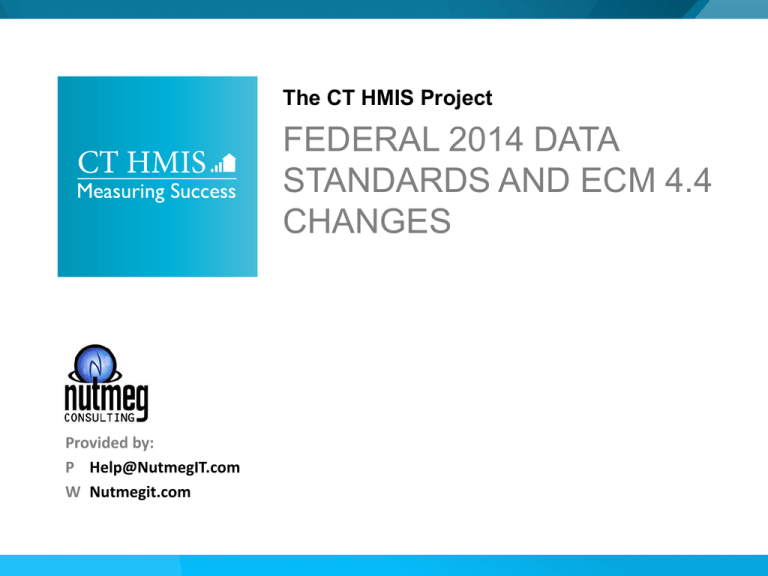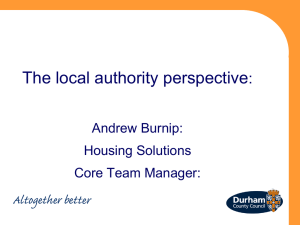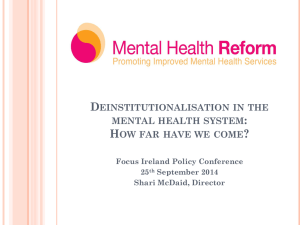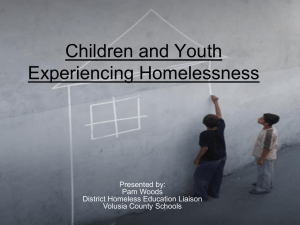2014 Data Standards Update
advertisement

The CT HMIS Project FEDERAL 2014 DATA STANDARDS AND ECM 4.4 CHANGES Provided by: P Help@NutmegIT.com W Nutmegit.com Before We Begin Please… Turn Your Cell Phone OFF or to SILENT MODE HUD HMIS Standards 2014 DATA STANDARDS UPDATE 2014 Data Standards Update Find and Read the Official Data Standards Documentation – HMIS Data Standards Manual (Full and detailed Explanation of each element) https://www.hudexchange.info/resource/3826/h mis-data-standards-manual/ – HMIS Data Dictionary https://www.hudexchange.info/resource/3824/h mis-data-dictionary/ 2014 Data Standards Update “If the client has an open record at the time you transition from the 2010 to the 2014 data standards the clients entry information will need to be updated at annual assessment or before to complete all of the required data elements required for the project that are now required to be collected at entry (i.e. new data standard elements). 2014 Data Standards Update • General Changes – “Don’t Know” becomes “Client doesn’t know” – “Refused” becomes “Client refused” – New “Data not collected” choice for the Y/N/DK/R lists for several questions – “Programs” are now referred to as “Projects” – Chronically Homeless questions now official HUD data standard Items! – “heads of household and adult household members” has replaced “All Adults” for many data elements to capture households with only minors 2014 Data Standards Update General Changes • DQ field for Name (All, Record Creation) – Full, Partial, street name, or code name reported, Client doesn’t know, Refused • SSN DQ Wording Change (All, Record Creation) – “Partial SSN reported” has been changed to “Approximate or partial SSN reported” – Doesn’t Know • Client Location (HoH, Entry) – CoC code assigned, can change as client moves to different facilities within a program enrollment 2014 Data Standards Update – Gender Choice Phrasing (Change, All, Record Creation) • “Transgendered” has been changed to “Transgender”. • “Other” now let’s you specify Text response. “Other” may include intersex individuals or persons who prefer not to identify a specific gender. – Veteran (Change, Adults, Record Creation) • Collected at client creation (Static) instead of program Entry – Residence Prior to Project Entry (New Options, Removed Options) • Hospital (non-psychiatric) expanded to: – – – – Long-term care facility or nursing home Residential project or halfway house with no homeless criteria Rental by client, with GPD TIP subsidy. Remove: • Language has been added to the “Permanent housing for formerly homeless persons” response to incorporate HOPWA programs. 2014 Data Standards Update • Length of stay in previous place (New Options, HoH+Adults, Entry) – One day or less – Two days to one week • WAS “One week or less” • Destination (New Options, HoH+Adults, Exit) – Long-term care facility or nursing home – Moved from one HOPWA funded project to HOPWA PH – Moved from one HOPWA funded project to HOPWA TH – No exit interview completed 2014 Data Standards Update • Relationship to Head of Household (New Field, All, Entry) – Self (head of household) – Head of household’s child – Head of household’s spouse or partner – Head of household’s other relation member (other relation to head of household) – Other: non-relation member 2014 Data Standards Update • Length of Time on Street, in an Emergency Shelter, or Safe Haven (New Elements, Changed Elements) – Will replace CT version of question • Continuously Homeless for at Least One Year • Number of Times the Client has been Homeless in the Past Three Years – NOW: 0,1,2,3,4,DK,R 5or more – WAS: One, first time homeless, Two or three times, Four or more times, DK,R • Total Number of Months Homeless in the Past Three Years – (If more than 12 months) “Number of Years Continuously Homeless” – May be calculated in CW based on Months – WAS: How long since you had a home/perm place to live? • Status Documented 2014 Data Standards Update • Housing Status (Updated – See Docs) (New Options) – Category 1 – Homeless – Category 2 – At imminent risk of losing housing – Category 3 – Homeless only under other federal statutes – Category 4 – Fleeing domestic violence – At-risk of homelessness – Stably housed – Client doesn’t know – Client refused Just prior to Project Entry (No longer shown on Exit) 2014 Data Standards Update “Category 3 – Homeless only under other federal statutes” Unaccompanied youth under 25 years of age, or families with children and youth, who do not otherwise qualify as homeless under this definition, but who: (i) Are defined as homeless under section 387 of the Runaway and Homeless Youth Act (42 U.S.C. 5732a), section 637 of the Head Start Act (42 U.S.C. 9832), section 41403 of the Violence Against Women Act of 1994 (42 U.S.C. 14043e–2), section 330(h) of the Public Health Service Act (42 U.S.C. 254b(h)), section 3 of the Food and Nutrition Act of 2008 (7 U.S.C. 2012), section 17(b) of the Child Nutrition Act of 1966 (42 U.S.C. 1786(b)), or section 725 of the McKinney-Vento Homeless Assistance Act (42 U.S.C. 11434a); AND (ii) Have not had a lease, ownership interest, or occupancy agreement in permanent housing at any time during the 60 days immediately preceding the date of application for homeless assistance; AND (iii) Have experienced persistent instability as measured by two moves or more during the 60-day period immediately preceding the date of applying for homeless assistance; AND (iv) Can be expected to continue in such status for an extended period of time because of chronic disabilities, chronic physical health or mental health conditions, substance addiction, histories of domestic violence or childhood abuse (including neglect), the 2014 Data Standards Update • Income and Sources (HoH+Adults*) (New Options, New Rules, Removed Options) – Projects are now required to record only sources of income that are current as of the information date. (No last 30 days) – Under the previous data standards income estimation was not allowed. It is now required if the actual amount of income is not certain. – Veteran’s disability payment is now VA ServiceConnected Disability Compensation – Veteran’s pension is now VA Non-Service-Connected Disability Pension. – Under the previous data standards, collection of this information was required for all clients; recording income for minor children on the minor child’s record is no longer required 2014 Data Standards Update • Non-Cash Benefits (Changes, New Rules, HoH+Adults) – Projects are now required to record only sources of non-cash benefits that are current as of the information date. (No last 30 days) – Under the previous data standards, this data element was required for all clients. This has been changed so that data collection is required for all heads of household and adult household members. – Health insurance coverage sources have been moved into a separate data element. 2014 Data Standards Update • Health Insurance (All Clients, New Element) – Covered by Health Insurance (y/n/dk/r) – Sources • • • • • • Medicaid Medicare State Children’s Health Insurance Program (Husky) Health insurance obtained through COBRA Private Pay Health Insurance State Health Insurance for Adults – For HOPWA programs, if no “reason” • • • • • • Applied; decision pending Applied; client not eligible Client did not apply Insurance type N/A for this client Client doesn’t know Client refused 2014 Data Standards Update • Physical Disability (New Elements, All Clients) – Expected to be of long-continued and indefinite duration – substantially impairs ability to live independently – Documentation of the disability and severity on file – Currently receiving services / treatment for this condition • Developmental Disability (New Elements , All Clients) – Expected to substantially impair ability to live independently – Documentation of the disability and severity on file – Currently receiving services/ treatment for this condition • Chronic Health Condition (New Elements , All Clients) – Expected to substantially impair ability to live independently – Documentation of the disability and severity on file – Currently receiving services / treatment for this condition • HIV / AIDS (New Elements , All Clients) – Expected to substantially impair ability to live independently – Documentation of the disability and severity on file – Currently receiving services / treatment for this condition 2014 Data Standards Update • • • • Mental Health Problem (New Elements, All Clients) – Expected to be of long-continued and indefinite duration and substantially impairs ability to live independently – Documentation of the disability and severity on file – Currently receiving services / treatment for this condition Developmental Disability (New Elements, All Clients) – Expected to substantially impair ability to live independently – Documentation of the disability and severity on file – Currently receiving services / treatment for this condition Chronic Health Condition (New Elements, All Clients) – Expected to substantially impair ability to live independently – Documentation of the disability and severity on file – Currently receiving services / treatment for this condition Currently receiving services/ treatment for this condition HIV / AIDS (New Elements, All Clients) – Expected to substantially impair ability to live independently – Documentation of the disability and severity on file – Currently receiving services / treatment for this condition 2014 Data Standards Update Expected to be of long-continued and indefinite duration and substantially impairs ability to live independently means 1. expected to be of long, continued and indefinite duration 2. substantially impedes an individual’s ability to live independently, and 3. of such a nature that such ability could be improved by more suitable housing conditions. Documentation of the disability and severity on file requirements vary by federal funding program so specific guidance around acceptable documentation will be provided in the Program Specific Manuals. 2014 Data Standards Update • Residential Move-In Date (New Fields, RRH) – In Permanent Housing (y/n) – (If yes) Date of Move-In 2014 Data Standards Update Housing Assessment Disposition (New Field, HoH, Project Exit) • New Data Elements for Coordinated Assessment programs – – – – – – – – – – – – – – Referred to emergency shelter/safe haven Referred to transitional housing Referred to rapid re-housing Referred to permanent supportive housing Referred to homelessness prevention Referred to street outreach Referred to other continuum project type Referred to a homelessness diversion program Unable to refer/accept within continuum; ineligible for continuum projects Unable to refer/accept within continuum; continuum services unavailable Referred to other community project (non-continuum) Applicant declined referral/acceptance Applicant terminated assessment prior to completion Other/specify 2014 Data Standards Update • Housing Assessment at Exit (New Field, All Clients) – – – – – – – – – – – Able to maintain the housing they had at project entry Moved to new housing unit Moved in with family/friends on a temporary basis Moved in with family/friends on a permanent basis Moved to a transitional or temporary housing facility or program Client became homeless – moving to a shelter or other place unfit for human habitation Client went to jail/prison Client died Client doesn’t know Client refused Subsidy information (If Able to maintain the housing) • Without a subsidy • With the subsidy they had at project entry • With an on-going subsidy acquired since project entry • Only with financial assistance other than a subsidy – Subsidy information (If Moved to new housing unit) • With an ongoing subsidy • Without an ongoing subsidy 2014 Data Standards Update • PATH – Path Funded Services (HUD Categories) • • • • • • • • • • • • • Outreach Screening/assessment Habilitation/rehabilitation Community mental health Substance use treatment Case management Residential supportive services Housing minor renovation Housing moving assistance Housing technical assistance Security deposits One-time rent for eviction prevention Other PATH funded service 2014 Data Standards Update • PATH – Referrals Provided (Categories) • • • • • • • • • • • Community Mental Health Substance Use Treatment Primary Health Services Job Training Educational Services Relevant Housing Services Housing Placement Assistance Income Assistance Employment Assistance Medical Assistance + Status: Attained/Not/Unknown – PATH Enrollment Status (Yes/No/Ineligible/Other) – Connection with SOAR (At Exit) • Workflow Changes (No duplicate enrollments!) • Report Changes (Waiting on FINAL standards on report) 2014 Data Standards Update • HOPWA – Services Provided (HUD Categories) • • • • • • • • • • • • • • Adult day care and personal assistance Case management Child care Criminal justice/legal services Education Employment and training services Food/meals/nutritional services Health/medical care Life skills training Mental health care/counseling Outreach and/or engagement Substance abuse services/treatment Transportation Other HOPWA funded service 2014 Data Standards Update • HOPWA (STRMU and PHP) – Financial Assistance Provided (Categories) • • • • • Rental assistance Security deposits Utility deposits Utility payments Mortgage assistance 2014 Data Standards Update HOPWA • Medical Assistance (New Field) – Receiving Public HIV/AIDS Medical Assistance • (if no) Reason – Receiving AIDS Drug Assistance • (if no) Reason * Reason is visible for other program types, but NOT required. 2014 Data Standards Update VA and SSVF • Services Provided (SSVF) – Type of Service • Direct provision of other public benefits – – – – – – – Personal financial planning services Transportation services Income support services Fiduciary and representative payee services Legal services – child support Legal services – eviction prevention Legal services – outstanding fines and penalties • Other (non-TFA) supportive service approved by VA – Text Box for Other 2014 Data Standards Update VA and SSVF • Financial Assistance Provided (SSVF) – – – – – – – – – Rental assistance Utility fee payment assistance Security deposit Utility deposit Moving costs Transportation services: tokens/vouchers Transportation services: vehicle repair/maintenance Child Care General housing stability assistance - emergency supplies – General housing stability assistance - other – Emergency housing assistance 2014 Data Standards Update Veterans (New Fields, Updated Fields) • Year Entered Military Service • Year Separated from Military Service • Theatre of Operation – – – – – – – – World War II Korean War Vietnam War Persian Gulf War (Operation Desert Storm) Afghanistan (Operation Enduring Freedom) Iraq (Operation Iraqi Freedom) Iraq (Operation New Dawn) Other Peace-keeping Operations or Military Interventions (such as Lebanon, Panama, Somalia, Bosnia, Kosovo) • Branch of the Military • Discharge Status • Address Prior to Entry DQ) (Address, City, State, Zip, Address CASEWORTHY 4.4 CHANGES ECM 4.4 Timeline* • Schedules System Downtime – Saturday 10/4 through Tuesday 10/7 Plan Accordingly! * Subject to Change New ROI Form Updated ROI Form in CW ECM 4.4 Enhancements • ECM ID displayed under Client Name • One login can be assigned multiple Organizations (yay!) • New Alert Style ECM 4.4 Enhancements • Enhanced Client Demographic Screen – Contact Info (non-required) • • • • Suffix (Jr, Sr, etc.) Cell / Work / Home # Email Address Citizenship Status – Current Housing Situation (non-required) ECM 4.4 Enhancements • Project Setup – Funders can be recorded in ECM per Project • Multiple Funders per program – Grant IDs – CoC Codes are linked to providers (and clients) • Facility Setup (Resources, beds, units, etc) – New Target Pops (Veteran and Youth) • New “official” Anonymous feature tacks on Client ID, based on DQ options of “Refused”, “Data Not Collected”, and “Client Doesn’t Know,” ECM 4.4 Enhancements • More robust “Copy assessment” feature – Choose Any enrollment/assessment – Auto-pops up a prompt asking if you’d like to copy assessment data • New Assessment Type for “Annual” in addition to the Entry/During Program / Exit – Annual restricted by date to within 30 days of initial date ECM 4.4 Enhancements • Pause/Resume multiple workflows ECM 4.4 Enhancements Household Relationship per Project Enrollment • 2014 HUD Standards require a new field to capture the relationship to head of household specific to enrollment allowing different family compositions for each individual project enrollment. • On this form, the relationship to HOH defaults to the relationship setup on the Add Family Member form. • Changes made on the enrollment relationship to HOH only affect the family composition for this enrollment. For example, a household with two adults and three minors might have an adult HOH, but if the three minors were to enroll in a program without the adults, one would need to be set as the HOH on the Add Enrollment Members form. HUD reports family member composition by enrollment. ECM 4.4 Enhancements HMIS Enrollment Members P 866-721-HMIS (4647) W CTHMIS.com E HMIS@NutmegIT.com







